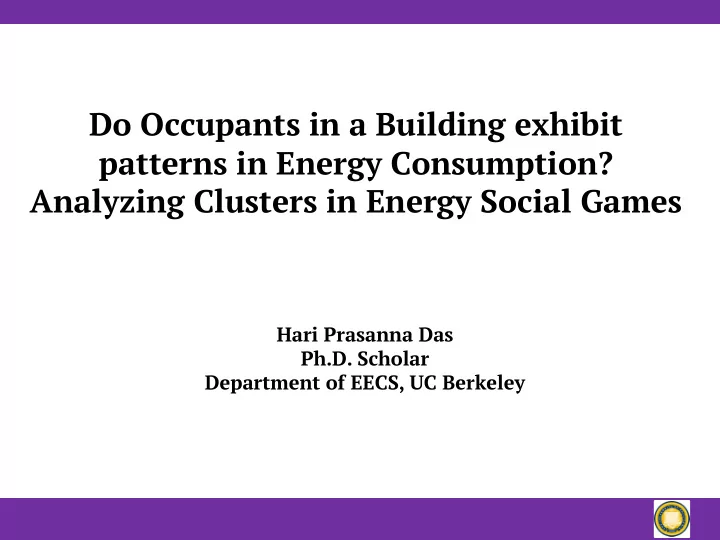

Do Occupants in a Building exhibit patterns in Energy Consumption? Analyzing Clusters in Energy Social Games Hari Prasanna Das Ph.D. Scholar Department of EECS, UC Berkeley
Joint work with Hari Prasanna Das Ioannis C. Konstantakopoulos Aummul B. Manasawala EECS, UC Berkeley EECS, UC Berkeley IEOR, UC Berkeley Huihan Liu Costas J. Spanos Tanya Veeravalli EECS, UC Berkeley EECS, UC Berkeley EECS, UC Berkeley
The Smart Building Paradigm Energy Consumption of buildings, both residential and commercial, account for • approximately 40% of all energy usage in the U.S. Achieving energy efficiency in buildings is crucial • Methods for achieving energy efficiency: • Making occupants Making building infrastructure smart and energy efficient energy efficient Energy Game-Theoretic Frameworks Source: Singapore Berkeley Building Efficiency and Sustainability in the Tropics (SinBerBEST) www.sinberbest.berkeley.edu
Energy Game-Theoretic Framework Incentivize occupants to modify their behavior in a competitive game setting so that the over-all energy consumption in the building is reduced.
Utility learning is hard To efficiently decide incentive for each occupant/player in the game, we need to know their utility function (preference towards energy usage) Individual Utility learning is hard Number of players is high • Quality data for each player • unavailable Human behavior resulting in • utility function has high variance Our Proposal: Segment the energy usage behavior of players into finite clusters. Under the assumption that players in a cluster will behave synchronously.
Supervised vs. Unsupervised Segmentation Supervised Segmentation Unsupervised Segmentation Requires a supervision signal: we use No supervision required • • rank of player Segments players as a whole into Segments energy usage behaviors • • different classes into different clusters Undesirable Desirable Provides labels of the classes as No information about labelling of • • high/medium/low energy efficient clusters Undesirable Desirable Our Approach: A hybrid segmentation method
Tool for proposed segmentation: Graphical Lasso Graphical Lasso is a sparse penalized maximum likelihood estimator • Features (𝑍) are associated with the vertex set 𝑊 = {1,2, … , 𝑇} of some underlying • graph. The structure of the graph is utilized to derive inferences about the relationship • between the features. For undirected graphical models, node for 𝑍𝑡 is conditionally independent of • nodes not directly connected to it given 𝑍 !\# . So the predictor for 𝑍𝑡 is written as, The 𝛾 $ terms dictate the edge set for node s in the • graph. Obtain 𝛾 $ , by solving the lasso problem
Proposed Segmentation Method
Social Game Dataset Energy Social Game time-stamped data in per-minute resolution: 1. Resource (Ceiling/Desk Light, Fan, A/C) Status 2. Gathered points (from games and surveys) 3. Rank in the game 4. Frequency of visit to web portal 5. Weather metric such as humidity, temperature and solar radiation 6. Dummy features: Weekdays/Weekends/Midterms/Breaks/Finals Ref: “Design, Benchmarking and Explainability Analysis of a Game-Theoretic Framework towards Energy Efficiency in Smart Infrastructure”, I. C. Konstantakopoulos, H. P. Das, A. R. Barkan, S. He, T. Veeravalli, H. Liu, A. B. Manasawala, Y. Lin and C. J. Spanos, arXiv preprint arXiv:1910.07899, 2019
Feature Correlation Learning using Graphical Lasso For Low energy efficient class
Feature Correlation Learning using Graphical Lasso For Medium energy efficient class
Feature Correlation Learning using Graphical Lasso For High energy efficient class
Causality Analysis using Grangers Causality Enhances the explainability nature of our model Under null-hypothesis, X does not cause Y
Unsupervised Clustering Principal Component Analysis (PCA) followed by minibatch K-means
Feature Correlation Learning using Graphical Lasso For an unsupervised cluster
Feature Correlation Learning using Graphical Lasso
Conclusions and Future Work A framework for segmentation analysis in energy game-theoretic frameworks • Clustering of agent behaviors and an explainable statistical model • Characterization of causal relationship among several contributed features • explaining decision-making patterns in agent’s actions. Specific incentives can be designed for characteristic clusters • Future Work Tree based Incentive Design • Study of long term effects of • social game with improved incentive design
Thank You! Questions?
References “Design, Benchmarking and Explainability Analysis of a Game-Theoretic • Framework towards Energy Efficiency in Smart Infrastructure”, Ioannis C. Konstantakopoulos, Hari Prasanna Das, Andrew R. Barkan, Shiying He, Tanya Veeravalli, Huihan Liu, Aummul Baneen Manasawala, Yu-Wen Lin and Costas J. Spanos, arXiv preprint arXiv:1910.07899, 2019 “A Novel Graphical Lasso based approach towards Segmentation Analysis in Energy • Game-Theoretic Frameworks”, Hari Prasanna Das, Ioannis C. Konstantakopoulos, Aummul Baneen Manasawala, Tanya Veeravalli, Huihan Liu and Costas J. Spanos, arXiv preprint arXiv:1910.02217, 2019 Trevor Hastie, Robert Tibshirani, and Martin Wainwright. Statistical Learning with • Sparsity: The Lasso and Generalizations. Chapman & Hall/CRC, 2015
Energy Social Game Experiment Experimental environment: Residential housing single room apartments in Nanyang • Technological University (NTU), Singapore campus. Deployed IoT sensors for energy resource observation and employed an web- • interface for interaction with players Energy usage observed: Ceiling Light, Desk Light, A/C and Fan • Occupants were rewarded with points based on how energy efficient their daily • usage is in comparison to their past usage and usage of other players in the game.
Recommend
More recommend